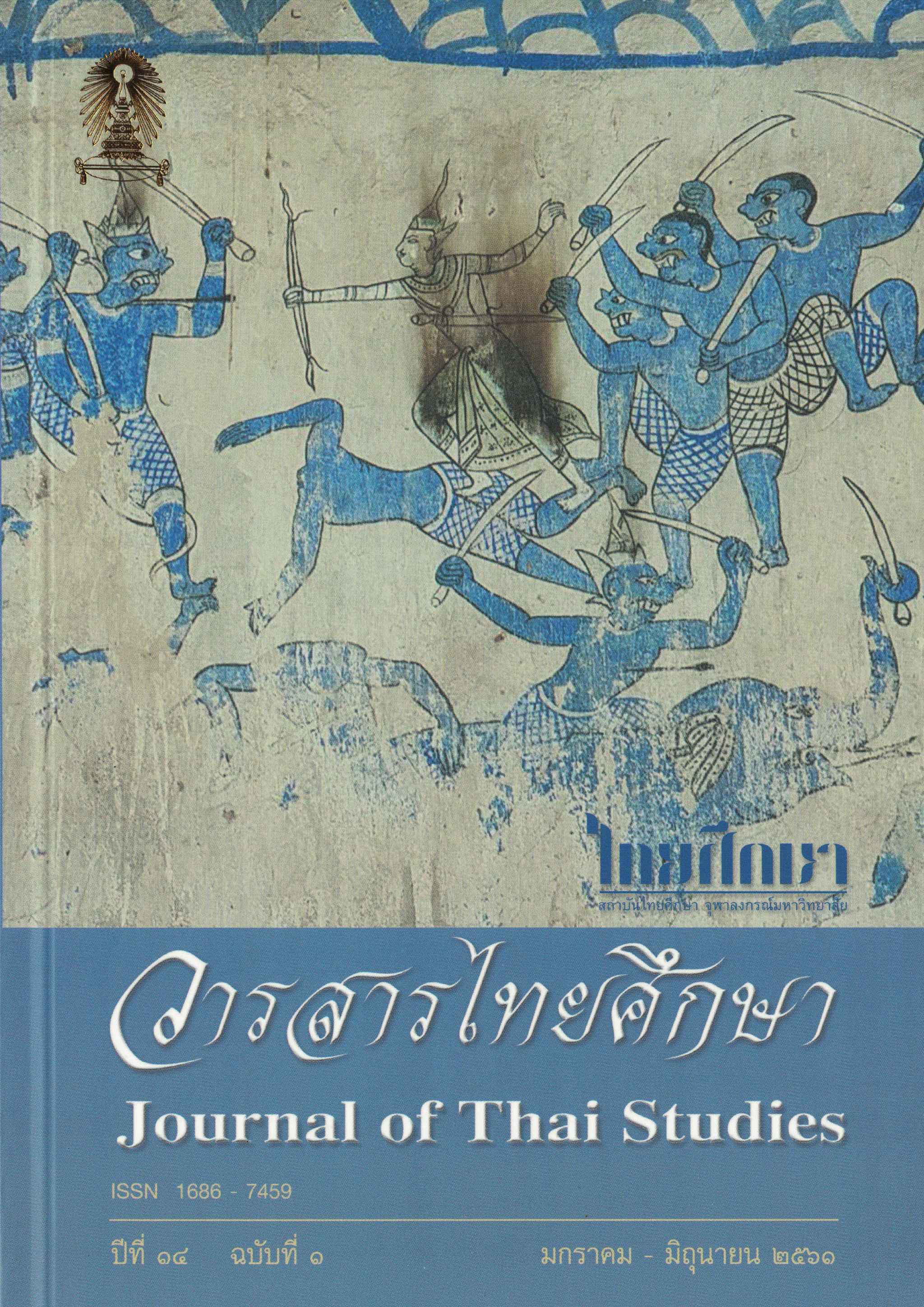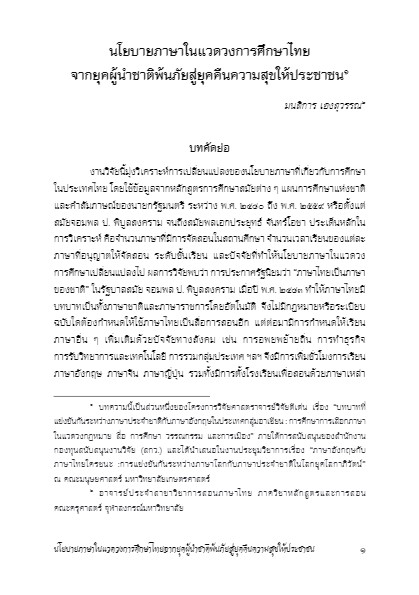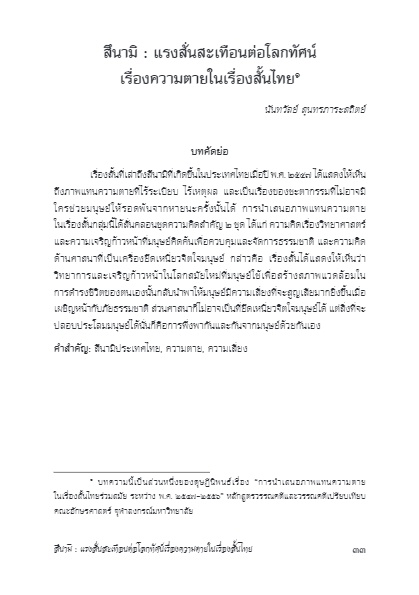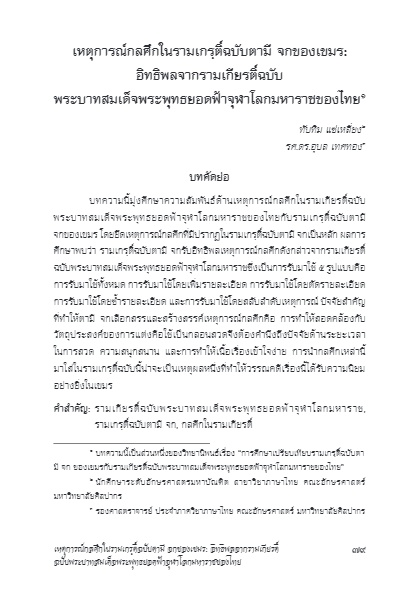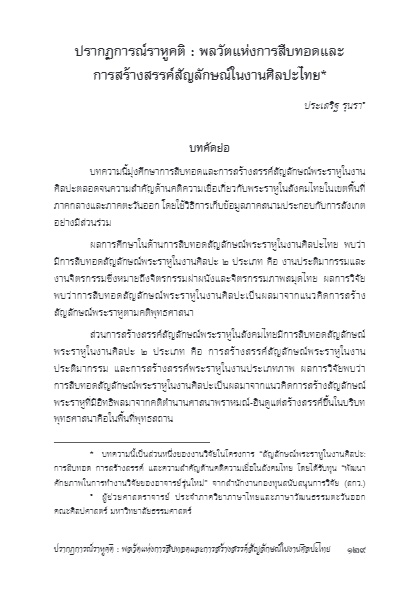วารสารไทยศึกษา - ปีที่ 14 ฉบับที่ 1

1) นโยบายภาษาในแวดวงการศึกษาไทยจากยุคผู้นำชาติพ้นภัยสู่ยุคคืนความสุขให้ประชาชน / มนสิการ เฮงสุวรรณ
2) สึนามิ : เรื่องสั่นสะเทือนต่อโลกทัศน์เรื่องความตายในเรื่องสั้นไทย / นันทวัลย์ สุนทรภาระสถิตย์
3) ความซับซ้อนเรื่องประเภทกับข้อถกเถียงเรื่องความเป็น “นิราศ” / น้ำผึ้ง ปัทมะลางคุล
4) เหตุการณ์กลศึกในรามเกรฺติ์ฉบับตามี จกของเขมร : อิทธิพลจากรามเกียรติ์ฉบับพระบาทสมเด็จพระพุทธยอดฟ้าจุฬาโลกมหาราชของไทย / ทับทิม แซ่หลี่ยง, อุบล เทศทอง
5) บทบาทของพระอิศวรในนิทานพื้นบ้านไทย / แคทรียา อังทองกำเนิด
6) ปรากฏการณ์ราหูคติ : พลวัตแห่งการสืบทอดและการสร้างสรรค์สัญลักษณ์ในงานศิลปะไทย / ประเสริฐ รุนรา
นโยบายภาษาในแวดวงการศึกษาไทยจากยุคผู้นำชาติพ้นภัยสู่ยุคคืนความสุขให้ประชาชน
มนสิการ เฮงสุวรรณ
บทคัดย่อ
งานวิจัยนี้มุ่งวิเคราะห์การเปลี่ยนแปลงของนโยบายภาษาที่เกี่ยวกับการศึกษาในประเทศไทย โดยใช้ข้อมูลจากหลักสูตรการศึกษาสมัยต่างๆ แผนการศึกษาแห่งชาติและคำสัมภาษณ์ของนายกรัฐมนตรี ระหว่าง พ.ศ. 2480 ถึง พ.ศ. 2559 หรือตั้งแต่สมัยจอมพล ป. พิบูลสงคราม จนถึงสมัยพลเอกประยุทธ์ จันทร์โอชา ประเด็นหลักในการวิเคราะห์ คือจำนวนภาษาที่มีการจัดสอนในสถานศึกษา จำนวนเวลาเรียนของแต่ละภาษาที่อนุญาตให้จัดสอน ระดับชั้นเรียน และปัจจัยที่ทำให้นโยบายภาษาในแวดวงการศึกษาเปลี่ยนแปลงไป ผลการวิจัยพบว่า การประกาศรัฐนิยมว่า “ภาษาไทยเป็นภาษาของชาติ” ในรัฐบาลสมัย จอมพล ป. พิบูลสงคราม เมื่อปี พ.ศ. 2483 ทำให้ภาษาไทยมีบทบาทเป็นทั้งภาษาชาติและภาษาราชการโดยอัตโนมัติ จึงไม่มีกฎหมายหรือระเบียบฉบับใดต้องกำหนดให้ใช้ภาษาไทยเป็นสื่อการสอนอีก แต่ต่อมามีการกำหนดให้เรียนภาษาอื่นๆ เพิ่มเติมด้วยปัจจัยทางสังคม เช่น การอพยพย้ายถิ่น การทำธุรกิจ การรับวิทยาการและเทคโนโลยี การรวมกลุ่มประเทศ ฯลฯ จึงมีการเพิ่มชั่วโมงการเรียนภาษาอังกฤษ ภาษาจีน ภาษาญี่ปุ่น รวมทั้งมีการตั้งโรงเรียนเพื่อสอนด้วยภาษาเหล่านี้อีกด้วย การเปลี่ยนแปลงใด ๆ ที่เกิดขึ้นกับนโยบายภาษาในแวดวงการศึกษา แสดงให้เห็นถึงวิสัยทัศน์ทางด้านนโยบายภาษาของผู้นำรัฐบาล และสถานการณ์การช่วงชิงพื้นที่ระหว่างภาษาไทยซึ่งเป็นภาษาประจำชาติกับภาษาต่างประเทศ
คำสำคัญ : นโยบายภาษา, แวดวงการศึกษา, หลักสูตรการศึกษา, รัฐบาลไทย
(ตีพิมพ์ใน วารสารไทยศึกษา ปีที่ 14 ฉบับที่ 1 (มกราคม – มิถุนายน 2561) หน้า 1-31)
Changes in the Thai National Language Policy in the Education System from the Plaek Phibunsongkhram to Prayut Chan-o-cha Periods
Manasikarn Hengsuwan
Abstract
This research attempts to analyze the changes of language policy in education in Thailand by studying information in Thailand’s education curriculums, announcements and interviews by prime ministers from 2480-2559 B.E. – that is, from Field Marshal Plaek Phibunsongkhram to General Prayut Chan-O-Cha. The main issues are the number of languages that have been taught in schools, the number of hours of each language is allowed to be taught, and factors that cause changes to language policies in education. The results show that the Nationalist Announcement, which stated that “Thai language is Thailand’s national language”, in the government led by Field Marshal Plaek Phibunsongkhram in 2483 B.E. resulted in Thai language becoming the national and official language. This led to a situation whereby no other curriculum was needed to ensure that Thai language was used in instruction, except in cases where it was required to enforce the learning of other languages owing to social changes, such as migration, business, technology advancement and allying with other countries. This caused an increase in learning hours of English, Chinese and Japanese, as well as the establishment of schools that specifically teach those languages. Accordingly, changes in language policies in the education system have been indicators of the visions of government leaders, as well as a sign of the competition between Thai language and other languages.
Keywords : Language Policy, Education Domain, Curriculum, Thai Government
(Published in Journal of Thai Studies Volume 14 Number 1 (January – June 2018) Page 1-31)
บทความ / Full Text : Download
สึนามิ : เรื่องสั่นสะเทือนต่อโลกทัศน์เรื่องความตายในเรื่องสั้นไทย
นันทวัลย์ สุนทรภาระสถิตย์
บทคัดย่อ
เรื่องสั้นที่เล่าถึงสึนามิที่เกิดขึ้นในประเทศไทยเมื่อปี พ.ศ. 2547 ได้แสดงให้เห็นถึงภาพแทนความตายที่ไร้ระเบียบ ไร้เหตุผล และเป็นเรื่องของชะตากรรมที่ไม่อาจมีใครช่วยมนุษย์ให้รอดพ้นจากหายนะครั้งนั้นได้ การนำเสนอภาพแทนความตายในเรื่องสั้นกลุ่มนี้ได้สั่นคลอนชุดความคิดสำคัญ 2 ชุด ได้แก่ ความคิดเรื่องวิทยาศาสตร์และความเจริญก้าวหน้าที่มนุษย์คิดค้นเพื่อควบคุมและจัดการธรรมชาติ และความคิด
ด้านศาสนาที่เป็นเครื่องยึดเหนี่ยวจิตใจมนุษย์ กล่าวคือ เรื่องสั้นได้แสดงให้เห็นว่า วิทยาการและเจริญก้าวหน้าในโลกสมัยใหม่ที่มนุษย์ใช้เพื่อสร้างสภาพแวดล้อมในการดำรงชีวิตของตนเองนั้นกลับนำพาให้มนุษย์มีความเสี่ยงจะสูญเสียมากยิ่งขึ้นเมื่อเผชิญหน้ากับภัยธรรมชาติ ส่วนศาสนาก็ไม่อาจเป็นที่ยึดเหนี่ยวจิตใจมนุษย์ได้ แต่สิ่งที่จะปลอบประโลมมนุษย์ได้นั่นก็คือการพึ่งพากันและกันจากมนุษย์ด้วยกันเอง
คำสำคัญ : สึนามิประเทศไทย, ความตาย, ความเสี่ยง
(ตีพิมพ์ใน วารสารไทยศึกษา ปีที่ 14 ฉบับที่ 1 (มกราคม – มิถุนายน 2561) หน้า 33-60)
Tsunami : A Powerful Shake on the Vision of Death in Thai Short Stories
Nantawan Sunthonparasatid
Abstract
Short stories dealing with the tsunami that hit Thailand in 2006 are representations of disorder and irrational death, which is explained as the work of fate. The representation of death in the selected works incorporates two crucial assumptions: the belief in science and technology used to dominate the natural world and religious beliefs as a place of refuge. These short stories reveal that modern and breakthrough technology used to facilitate living, in fact, exposes people to more risk when they face natural disasters. Religion, at the same time, has not lost its importance. The selected short stories reveal that the only comfort is the unity of people.
Keyword : Tsunami Thailand, Death, Risk
(Published in Journal of Thai Studies Volume 14 Number 1 (January – June 2018) Page 33-60)
บทความ / Full Text : Download
ความซับซ้อนเรื่องประเภทกับข้อถกเถียงเรื่องความเป็น "นิราศ"
น้ำผึ้ง ปัทมะลางคุล
บทคัดย่อ
ประเภทเป็นประเด็นพื้นฐานประการหนึ่งในการศึกษาวรรณคดี เพราะเป็นสิ่งที่ทั้งผู้แต่งและผู้อ่านมักเชื่อมโยงตัวบทเข้ากับกรอบของความเป็นประเภท ในด้านของวรรณคดีไทย นิราศเป็นวรรณคดีที่ทำให้เกิดคำถามเกี่ยวกับความเป็นประเภทที่น่าสนใจยิ่ง บทความนี้จึงมุ่งสำรวจข้อถกเถียงเกี่ยวกับความเป็นประเภทของนิราศ และนำแนวคิดเกี่ยวกับประเภทจากทฤษฎีวรรณคดีวิจารณ์ตะวันตกมาอภิปรายประกอบ
เพื่อแสดงให้เห็นความซับซ้อนของความเป็นประเภท
คำสำคัญ : ประเภทวรรณคดี, นิราศ
(ตีพิมพ์ใน วารสารไทยศึกษา ปีที่ 14 ฉบับที่ 1 (มกราคม – มิถุนายน 2561) หน้า 61-78)
The Complexity of the Genre and the Debate Regarding Nirat
Namphueng Padamalangula
Abstract
Genre is a fundamental issue in studying literature as both authors and readers tend to link the texts with the genres they belong to. In terms of Thai literature, nirat is a group of texts that raises interesting questions regarding genre. With the aid of Western literary theory regarding genre studies, this article aims to explore the debate on nirat and its complexity as a genre.
Keywords: genre, Nirat
(Published in Journal of Thai Studies Volume 14 Number 1 (January – June 2018) Page 61-78)
บทความ / Full Text : Download
เหตุการณ์กลศึกในรามเกรฺติ์ฉบับตามี จกของเขมร : อิทธิพลจากรามเกียรติ์ฉบับพระบาทสมเด็จพระพุทธยอดฟ้าจุฬาโลกมหาราชของไทย
ทับทิม แซ่หลี่ยง และ อุบล เทศทอง
บทคัดย่อ
บทความนี้มุ่งศึกษาความสัมพันธ์ด้านเหตุการณ์กลศึกในรามเกียรติ์ฉบับพระบาทสมเด็จพระพุทธยอดฟ้าจุฬาโลกมหาราชของไทยกับรามเกรฺติ์ฉบับตามี จกของเขมร โดยยึดเหตุการณ์กลศึกที่มีปรากฏในรามเกรฺติ์ฉบับตามี จกเป็นหลัก ผลการศึกษาพบว่า รามเกรฺติ์ฉบับตามี จกรับอิทธิพลเหตุการณ์กลศึกดังกล่าวจากรามเกียรติ์ฉบับพระบาทสมเด็จพระพุทธยอดฟ้าจุฬาโลกมหาราชซึ่งเป็นการรับมาใช้ 5 รูปแบบคือ การรับมาใช้ทั้งหมด การรับมาใช้โดยเพิ่มรายละเอียด การรับมาใช้โดยตัดรายละเอียด การรับมาใช้โดยซ้ำรายละเอียด และการรับมาใช้โดยสลับลำดับเหตุการณ์ ปัจจัยสำคัญที่ทำให้ตามี จกเลือกสรรและสร้างสรรค์เหตุการณ์กลศึกคือ การทำให้สอดคล้องกับวัตถุประสงค์ของการแต่งคือใช้เป็นกลอนสวดจึงต้องคำนึงถึงปัจจัยด้านระยะเวลาในการสวด ความสนุกสนาน และการทำให้เนื้อเรื่องเข้าใจง่าย การนำกลศึกเหล่านี้มาใส่ในรามเกรฺติ์ฉบับนี้น่าจะเป็นเหตุผลหนึ่งที่ทำให้วรรณคดีเรื่องนี้ได้รับความนิยมอย่างยิ่งในเขมร
คำสำคัญ : รามเกียรติ์ฉบับพระบาทสมเด็จพระพุทธยอดฟ้าจุฬาโลกมหาราช, รามเกรฺติ์ฉบับตามี จก, กลศึกในรามเกียรติ์
(ตีพิมพ์ใน วารสารไทยศึกษา ปีที่ 14 ฉบับที่ 1 (มกราคม – มิถุนายน 2561) หน้า 79-104)
Stratagems in the Ta Mi Chak Version of Khmer Reamker: Influences from King Rama I’s Rendition of Thai Ramakien
Tubtim Saliang and Ubol Tedtong
Abstract
This article investigates tactics and ploys used to outwit an opponent or achieve an end in King Rama I’s rendition of Ramakien, Thailand’s national epic, in comparison with the Ta Mi Chak version of Khmer Reamker, with a particular focus on the tactics and ploys found in the Ta Mi Chak version. It was found that the stratagems found in the Ta Mi Chak version were derived from Ramakien, with the influences manifested in five significant ways: complete adoption, adoption with the addition of details, adoption with the reductions of details, adoption with a repetition of details, and adoption with the chronological order of an event being rearranged. The Ta Mi Chak version selects and makes use of these stratagems since it was intended to be composed as a hymn. In so doing, it takes into consideration factors such as timing, amusement and content that must be easily digestible. This study suggests that the utilization and incorporation of these maneuvers is one reason that this particular piece of literature widely popular in Khmer.
Keywords : King Rama I Rendition of Ramakien, Ta Mi Chak Version of Khmer Reamker, Stratagems in Ramakien
(Published in Journal of Thai Studies Volume 14 Number 1 (January – June 2018) Page 79-104)
บทความ / Full Text : Download
บทบาทของพระอิศวรในนิทานพื้นบ้านไทย
แคทรียา อังทองกำเนิด
บทคัดย่อ
บทความวิจัยนี้มีวัตถุประสงค์เพื่อรวบรวมนิทานพื้นบ้านไทยที่กล่าวถึงบทบาทของพระอิศวร และศึกษาบทบาทของพระอิศวรที่ปรากฏในนิทานพื้นบ้านไทย จากการรวบนิทานพื้นบ้านไทยที่กล่าวถึงบทบาทของพระอิศวรจำนวน 30 เรื่องพบว่า บทบาทของพระอิศวรปรากฏในนิทานพื้นบ้านภาคใต้มากที่สุด รองลงมาคือนิทานพื้นบ้านภาคกลาง ภาคตะวันออกเฉียงเหนือ และภาคเหนือ บทบาทของพระอิศวรที่พบในนิทานพื้นบ้านไทยจำแนกได้เป็น 7 บทบาทคือ บทบาทของผู้ประทานพร บทบาทของผู้ปราบ บทบาทของผู้แก้ปัญหาหรือผู้ช่วยเหลือ บทบาทของผู้ควบคุมโลก บทบาทของผู้สร้างหรือผู้ให้กำเนิด บทบาทของผู้ท้าทายหรือถูกท้าทาย และบทบาทของผู้สั่งสอน จากการศึกษาบทบาทของพระอิศวรในนิทานพื้นบ้านไทยทั้ง 7 บทบาท จะเห็นได้ว่าแม้พระอิศวรในนิทานพื้นบ้านไทยจะมีบทบาทเช่นเดียวกับพระอิศวรในศาสนาพราหมณ์-ฮินดู แต่บทบาทของพระอิศวรในนิทานพื้นบ้านไทยนั้นมีการผสมผสานบทบาทของพระอิศวรให้สอดคล้องกับคติความเชื่อในพุทธศาสนาของไทย
คำสำคัญ : พระอิศวร, นิทานพื้นบ้านไทย, บทบาท
(ตีพิมพ์ใน วารสารไทยศึกษา ปีที่ 14 ฉบับที่ 1 (มกราคม – มิถุนายน 2561) หน้า 105-127)
The Role of Shiva in Thai Folktales
Catthaleeya Aungthongkamnerd
Abstract
The main purpose of this article is to compile Thai folktales and to study the roles of Shiva as portrayed in those folktales. Based on 30 Thai folktales, it is found that the role of Shiva is most frequently found in Southern Thai folktales, followed by the folktales from the central, the northern and the northeastern regions, respectively. Shiva’s roles in Thai folktales can be classified into seven groups: the giver, the conqueror, the helper, the world controller, the creator, the challenger (and also the one who is being challenged) and the educator. Although these seven roles played by Shiva in Thai folktales remain similar to those in Hinduism, it is found that certain modifications have been made in order to make Shiva’s role in Thai folktales appear more in line with Buddhist beliefs.
Keywords : Shiva, Thai folktales, roles
(Published in Journal of Thai Studies Volume 14 Number 1 (January – June 2018) Page 105-127)
บทความ / Full Text : Download
ปรากฏการณ์ราหูคติ : พลวัตแห่งการสืบทอดและการสร้างสรรค์สัญลักษณ์ในงานศิลปะไทย
ประเสริฐ รุนรา
บทคัดย่อ
บทความนี้มุ่งศึกษาการสืบทอดและการสร้างสรรค์สัญลักษณ์พระราหูในงานศิลปะตลอดจนความสำคัญด้านคติความเชื่อเกี่ยวกับพระราหูในสังคมไทยในเขตพื้นที่ภาคกลางและภาคตะวันออก โดยใช้วิธีการเก็บข้อมูลภาคสนามประกอบกับการสังเกตอย่างมีส่วนร่วม
ผลการศึกษาในด้านการสืบทอดสัญลักษณ์พระราหูในงานศิลปะไทย พบว่ามีการสืบทอดสัญลักษณ์พระราหูในงานศิลปะ 2 ประเภท คือ งานประติมากรรมและงานจิตรกรรมซึ่งหมายถึงจิตรกรรมฝาผนังและจิตรกรรมภาพสมุดไทย ผลการวิจัยพบว่าการสืบทอดสัญลักษณ์พระราหูในงานศิลปะเป็นผลมาจากแนวคิดการสร้างสัญลักษณ์พระราหูตามคติพุทธศาสนา
ส่วนการสร้างสรรค์สัญลักษณ์พระราหูในสังคมไทยมีการสืบทอดสัญลักษณ์พระราหูในงานศิลปะ 2 ประเภท คือ การสร้างสรรค์สัญลักษณ์พระราหูในงานประติมากรรม และการสร้างสรรค์พระราหูในงานประเภทภาพ ผลการวิจัยพบว่าการสืบทอดสัญลักษณ์พระราหูในงานศิลปะเป็นผลมาจากแนวคิดการสร้างสัญลักษณ์พระราหูที่มีอิทธิพลมาจากคติตำนานศาสนาพราหมณ์-ฮินดูแต่สร้างสรรค์ขึ้นในบริบทพุทธศาสนาคือในพื้นที่พุทธสถาน
ในด้านปัจจัยการสืบทอดสัญลักษณ์พระราหูในงานศิลปะพบ 3 ประการ ได้แก่ ประการแรก ความคิดเกี่ยวกับคติการสร้างพุทธสถานเป็นศูนย์กลางจักรวาล ประการที่สองความคิดเกี่ยวกับการบูชาพระพุทธเจ้าในอนาคต และประการสุดท้ายความคิดเกี่ยวกับกุศโลบายการสอนธรรมะในสังคมไทย ส่วนปัจจัยการสร้างสรรค์สัญลักษณ์พระราหูในงานศิลปะ พบปัจจัย 4 ประการ ได้แก่ ประการแรกอิทธิพลความเชื่อเกี่ยวกับโหราศาสตร์ในสังคมไทย ประการที่สอง ลักษณะและปรากฏการณ์ของพุทธศาสนาในสังคมไทย จำแนกเป็น 2 ปัจจัย คือ 1) พุทธศาสนาแบบประชานิยมในสังคมไทย และ 2) พุทธพาณิชย์ในสังคมไทย ประการที่สาม บทบาทหน้าที่ของพระราหูในฐานะสัญลักษณ์สากลในสังคมไทย และประการสุดท้ายการสร้างสรรค์ความหมายใหม่ของพระราหูในสังคมไทยปัจจุบัน จำแนกเป็น 3 ความหมาย คือ 1) พระราหู: สัญลักษณ์ของการสะเดาะเคราะห์ 2) พระราหู: สัญลักษณ์ของโชคลาภ และ 3) พระราหู: สัญลักษณ์ของการเปลี่ยนผ่าน
คำสำคัญ : พระราหู, สัญลักษณ์, คติความเชื่อ, การสืบทอด, การสร้างสรรค์
(ตีพิมพ์ใน วารสารไทยศึกษา ปีที่ 14 ฉบับที่ 1 (มกราคม – มิถุนายน 2561) หน้า 129-163)
Phenomenon of Belief in Rahu: Dynamics of Symbol Transmission and Creation in Thai Arts
Prasirt Runra
Abstract
This research focuses on the creation and succession of the Rahu symbol in Thai art, as well as the importance of the belief in Rahu in Thai society in the central, eastern and western regions by using field observation method, together with participant observation. The study of the succession of Rahu in Thai art found that there are two types of such representations: sculpture and Thai painting, including murals. The research found that the succession of the Rahu symbol in Thai art has been the result of the concept of Rahu according to Buddhism.
The research found that the concept of Rahu incorporates Brahman-Hindu ideas, but was created in a Buddhist context as it is used in Buddhist settings. The study found that the Rahu symbol is used in three ways. First is the idea of the creation of the Buddhist site as the center of the universe. Second is the idea of worshiping the Buddha in the future. The last factor is the idea of using Rahu to teach morals in Thai society. The symbolism of Rahu in art has four main factors. First, there is the idea of astrology in Thai society. Second are the characteristics and phenomena of Buddhism in Thai society, categorized into two factors: 1) popular Buddhism and 2) Buddhist commercialism. Third is the role of Rahu as a universal symbol in Thai society. Lastly, a new meaning of Rahu in Thai society can be classified into three meanings: 1) Rahu: the symbol for elimination of evil; 2) Rahu: the symbol of fortune; and 3) Rahu: the symbol of change.
Keywords : Rahu, Symbol, Belief, Transmission, Creation
(Published in Journal of Thai Studies Volume 14 Number 1 (January – June 2018) Page 105-127)
บทความ / Full Text : Download
